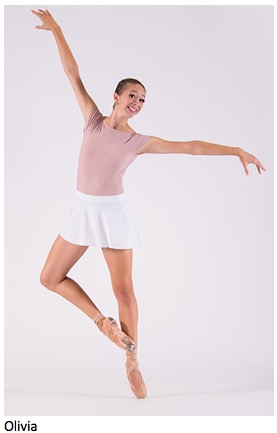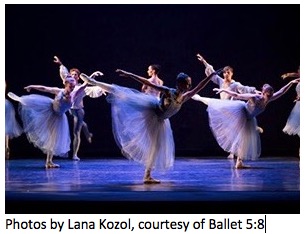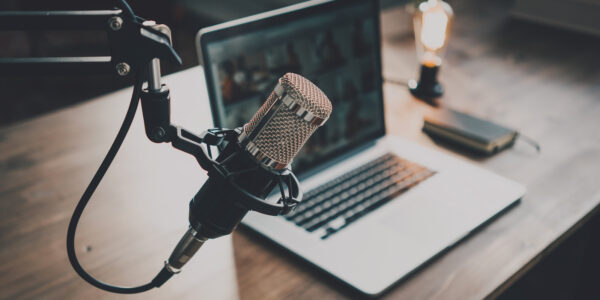Beauty. Art. Expression. All are meant to reflect the goodness and the design of the Creator. And when approached with a heart desiring to reflect this goodness, we learn more about ourselves as creation.
This is what Olivia Kruse has learned through her experience as a professional ballet dancer with a Christian ballet company in Chicago. In this interview with Radiant, Kruse shares not only how she has learned to glorify God and relate to God through dance, but what dance — and specifically ballet — reveals about the design of the human person. In essence, she shares her understanding of the theology of the body of ballet.
Radiant: How long have you been dancing? What about it captivates you?
 Olivia Kruse: I’ve been dancing for almost as long as I can remember! I think my mom signed me up for ballet classes when I was in kindergarten. When I was little, I was captivated by the music, the pretty tutus, the freedom to just be myself and express myself through movement. It was so fun to dance with all my friends in ballet class. I guess those aspects of ballet still captivate me today. But as I’ve grown older, my appreciation for the art form has also deepened. I love how in dance there is no time to worry about the past or the future, there is only the present. Just you, the steps and the music. There’s a freedom in dancing in time with the music and with the other dancers on stage. I feel really blessed to have dance in my life, because it constantly reminds me of the importance of being childlike with God and joyfully living in the present with him.
Olivia Kruse: I’ve been dancing for almost as long as I can remember! I think my mom signed me up for ballet classes when I was in kindergarten. When I was little, I was captivated by the music, the pretty tutus, the freedom to just be myself and express myself through movement. It was so fun to dance with all my friends in ballet class. I guess those aspects of ballet still captivate me today. But as I’ve grown older, my appreciation for the art form has also deepened. I love how in dance there is no time to worry about the past or the future, there is only the present. Just you, the steps and the music. There’s a freedom in dancing in time with the music and with the other dancers on stage. I feel really blessed to have dance in my life, because it constantly reminds me of the importance of being childlike with God and joyfully living in the present with him.
Radiant: You work and perform for a Christian ballet company. Could you explain more about what led you to this group and how faith is lived out?
Kruse: I feel so fortunate to dance for an organization where I can live out my faith through my art. I dance for a Christian ballet company in Chicago called Ballet 5:8. At Ballet 5:8, (named after Romans 5:8), we strive to share stories of life and faith with our audiences. It’s our hope that every audience member leaves a performance with an awareness of the love that Christ has for us all. I love how art always tells a story and am so grateful this company allows me to take part in telling meaningful stories inspired by our faith.
Radiant: In our conversation, you shared that you’ve come to realize there is a theology of the body of ballet and dance in general. Could you explain this?
Kruse: I’ve always loved ballet for its grace and discipline. There’s a sort of ethereal quality that ballet possesses. Pointe shoes allow ballerinas to dance on the tips of their toes, making it easier to give the illusion of defying gravity. When a male and female ballet dancer dance on stage together, it’s called a pas de deux. In French, this just means a dance for two. There are moments in a pas de deux when the dancers execute their own steps separately, but a majority of the dance is spent “partnering.” Partnering is just a term we use in ballet any time the male dancer helps the female dancer execute a step she otherwise wouldn’t be able to do on her own. An example of this would be lifting the ballerina up high to make a jump even higher or turning her around while she stays balanced on her pointe shoes. It is in this partnership that I think the godly relationship between man and woman can really be showcased.
 Both male and female ballet dancers have qualities about their dancing that separates them from the other. That’s not to say that one is better than the other, just different. The female ballerina wears pointe shoes, executing intricate steps such as balances, jumps and pirouettes with a graceful strength. It’s said that female dancers have to exert up to 10 times their body weight to come up and down off of their pointe shoes. The male dancer has to execute steps with pristine technique, taking off for jumps that seem to freeze in the air like an NBA player, then landing on cue with poise. They not only have to possess this explosive power in their movement, but also possess a steadiness in their strength to lift the female dancers and a confidence to take the lead in the dance.
Both male and female ballet dancers have qualities about their dancing that separates them from the other. That’s not to say that one is better than the other, just different. The female ballerina wears pointe shoes, executing intricate steps such as balances, jumps and pirouettes with a graceful strength. It’s said that female dancers have to exert up to 10 times their body weight to come up and down off of their pointe shoes. The male dancer has to execute steps with pristine technique, taking off for jumps that seem to freeze in the air like an NBA player, then landing on cue with poise. They not only have to possess this explosive power in their movement, but also possess a steadiness in their strength to lift the female dancers and a confidence to take the lead in the dance.
When dancing together, they highlight the strengths they each possess and create a heightened state of beauty together. With her partner’s help, the ballerina can jump higher, pirouette with more revolutions, balance longer, etc. Her elegance and graceful strength are taken to new heights with the help of the male dancer. And through this partnering, the male dancer’s strength is called to greater heights as well. It is his responsibility to ensure the ballerina meets her highest potential. His strength lifts her up. It’s not in frailty or weakness that she relies on him, but rather knowing he possesses different strengths than she does, and that together they can create art that otherwise would not exist.
Partnering work in ballet is extremely difficult. It takes such teamwork. The dancers have to move as one. They have to dance [to] the music, execute their steps, and give 100% of their energy and strength into executing the pas de deux together. It takes a vulnerability and a trust between the dancers. It also showcases such humility between the male and female. Limitations, like gravity and the mere mechanics of pointe shoes, put some restrictions on the female’s dancing, but with the help of her partner, the possibilities are endless. The male dancer humbles himself and uses his strength to enable the female to radiate all the more profoundly. He always kindly offers his hand to her, initiating the dance. There is such respect for her, knowing that her safety is his responsibility.
Dance has the power to showcase the beauty of man and woman. It has the potential to make visible respect, humility and strength through movement. I think that’s one of the reasons my heart is so drawn to ballet. The other-worldliness, the grace and purity, the humble partnership on display in ballet — it radiates of Christ’s love for us. It helps make tangible the intangible, drawing our hearts to desire true relationship with one another, which in turn leads to relationship with him. It is such a shame that sometimes dance is done provocatively, seemingly only having selfish intentions. This is so limiting to the true beauty that dance can convey. I love how ballet, specifically a pas de deux, can highlight the dignity between man and woman, calling us out of ourselves to use our gifts to strengthen and complement the other.
Radiant: How else has dance impacted your faith?
Kruse: I’m so thankful for dance and all the lessons I’ve gained from it. Dance has taught me determination, vulnerability and most importantly how to let go of the false notion of perfection — letting God have my brokenness and my humanness, and allowing him to be my savior, while trying everyday to live for him and glorify him. Dance has helped strengthen my faith, and because of this, all of my dancing is done in joy and thanksgiving for the Lord.
Olivia Kruse was born and raised in Fort Wayne, Indiana. She has a twin brother and loves that all her cousins also live nearby. She began her dance training at Project Ballet and later attended the University of Utah’s School of Dance, graduating with a BFA in Ballet and a BS in Psychology. Olivia is extremely humbled to currently dance with Ballet 5:8 in Chicago. She would like to thank her family for their unending support and God for his grace and guidance!




